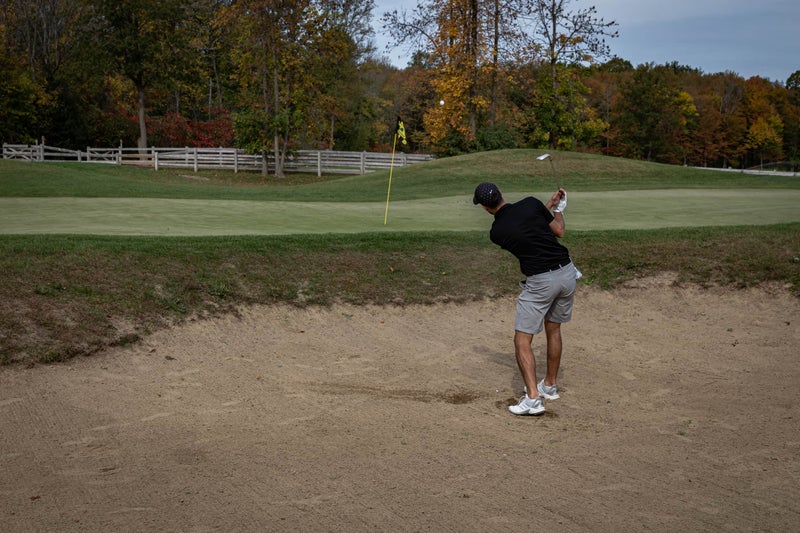-
{{link.label}}{{link.label}}
10 Common Beginner Mistakes in Golf
On this page
Golf is a wonderful sport, but no one can deny that it can get very challenging, and even frustrating at times. While there are plenty of reasons why golfers get frustrated on the golf course, this article will highlight the most common ones and offer suggestions as well as beginner golf tips on how to counter these frustrations.

From overthinking to leaving your putts short on the green, there are many factors that can fuel your frustration over the course of a round of golf. Fortunately for you, there are solutions and easy golf tips that exist to counter these frustrations.
The following guide will highlight:
- The 10 most common issues for golfers on the course
- How these issues can impact your scorecard
- Solutions to fix the issues that affect your golf game
1. Overthinking

Overthinking is the most common issue amongst golfers of all levels. Though it may not be the most prevalent issue for all golfers, the vast majority will mention having issues with overthinking at some point when they’re out on the course.
Overthinking shots can lead you to spend too much time over the ball which can result in your body tensing up, something you want to avoid when swinging a club, or simply lead to forget how to swing your golf club. Additionally, it can create some confusion in your mind when you’re on the green trying to read the lines and prevent you from committing to your shot.
How to fix this issue:
- Adopt a proper pre-shot routine by creating a repeatable sequence on which you can rely when you’re in doubt. This will not only help you get mentally prepared, but it will also help you with muscle memory, a key aspect of the golf swing. A commonly used routine by golfers is to stand behind the ball with the club in hand for a few seconds to visualize the strike, step up to the ball take a practice swing or two, and then go ahead with your strike.
2. Not committing to the shot

As we alluded to, not committing to your shot can also be very damaging to your scorecard. This may sound cliché to experienced golfers, but it’s still one of the biggest issues for golfers of all skill levels. Just like overthinking, not thinking your shot through can end up being just as costly.
Off the tee or down in the alley, hitting a shot without committing to it can lead to a wayward strike that can directly affect your scorecard. On the green, doubt will almost always end up with you leaving your putts short.
How to fix the issue:
- Decide on how you’ll strike the ball before setting up for your shot or even beginning your pre-shot routine. Whether you do it while walking to your ball or you make up your mind quickly once you get to your ball, deciding on how you’ll hit the ball should be at the top of your priorities.
3. Playing the wrong tees

Playing from the wrong set of tees will undoubtedly have an impact on your scorecard. When you’re teeing off from a set of tees that is too far back for your skill level, you’re simply making the game harder for yourself. Also, playing from too far back on the course will lead to slower rounds for not only you but the people behind you as well.
On the other hand, playing from tees that are too short for your skill level will often end up with you having to pull out a wedge on your second shot or it will even allow you to reach the green on holes that shouldn’t be drivable. The nice thing about playing closer, however, is that your score will also tend to shrink.
How to fix the issue:
- Move up one set of tees to shorten the length of holes and take the driver out of play which tends to be an issue for many who are just starting to play golf;
- Mix up the tees to create a combo set of your own that will be more fitting to your game. Some courses will have this feature on their scorecards, but you can always do that yourself to make the game more fun!
4. Can’t hit any fairways with the driver

This is a very common complaint amongst weekend golfers who go out on the course once a week for their weekly round with their crew. Even the best of pros will tell you that hitting the fairway with consistency is very difficult, which is why you should temper your expectations.
But we can certainly understand the frustration that comes along with always playing from the rough or even worst. Additionally, it becomes much more difficult to reach greens in regulation when you’re hitting from anywhere other than the fairway.
How to fix the issue:
- Select another golf club than your driver, especially if you’re having issues with it as the penalty from hitting any other club will never be as bad as an offline driver strike;
- Play to your shot by setting yourself in the best position according to your swing. Do you have a bad slice off the tee? Make sure to align yourself to compensate for the trajectory of the ball.
5. Picking the wrong golf club

Picking the right club can be very difficult, especially for less experienced players as they don’t have the same amount of knowledge. Tight lies and tricky ball placement, especially when your ball is completely out of line will make you question your club choice, but that is entirely part of the game of golf.
Struggling to decide between the clubs you’re playing out of the fairway shouldn’t be affecting your game, but some players simply can’t escape those frustrations. Picking the right club can be the difference between a chance for a birdie or a difficult up and down that can result in a bogey.
How to fix the issue:
- Learn the yardage of your clubs before heading out on the course for a full round of golf. This will give you a great advantage on the course as it will allow you to pick the right golf clubs for the desired distance;
- Take one more club than you think you need. Tempo and consistency, rather than power, should be your priority as an amateur, which means that taking a longer club and focusing on completing a fully controlled swing will produce better results.
6. Unable to get the ball on the green in regulation

Getting the ball on the green is a challenge for many golfers but getting on there in regulation (the number of strokes expected out of a player to reach the green) can be even more troublesome for most.
Placing your ball in putting position in two on par-4 will not only give you a chance at birdie, but it’ll also add one green in regulation (GIR) to your scorecard. The same goes for par-3s in one stroke and par-5s in three (or fewer). Not being able to score a lot of GIR will end up being costly on the scorecard.
How to fix the issue:
- Record your GIR stats when you’re playing, it’ll serve as a guide and a reference for how you’re performing and from what distance you need to work on the most;
- Hitting more fairways off the tee will allow you to have a better look at the green than playing from difficult lies in the rough;
- Use a distance measuring device like a rangefinder or a GPS watch will also help you have a better idea of how much distance you’ve got to work with.
7. Struggling to read the lines on a putt

There’s no denying it, reading greens is an art form which requires a lot of experience. Beginners are not expected to read putts with accuracy as they’re new to the sport. But if you’ve been playing for many years and are still struggling with reading putts, a growing frustration would be understandable.
Reading the lines on the green plays a major role in the success of your putting game. Your odds of rolling in a long putt without reading the line to the hole are astronomically lower than when you do. Having a strong putting game can salvage a bad swing day on the scorecard, or it can help you achieve your personal best!
How to fix the issue:
- Adopt a visual green-reading technique like AimPoint which allows you to read the lines of the green through a series of pre-established steps designed to measure the break on your putt;
- Keep it simple by only looking at the highest points on the green. By simply finding the high points, you’ll be able to make out the slopes and your putting line.
8. Leaving putts shorts

Missing a putt because you didn’t hit the ball hard enough on the green is guaranteed to lead to some frustration, regardless of who is putting the ball. Leaving a putt short can be explained by many factors, but the one constant is that the golfer who hit the putt wasn’t committed to the strike.
Most of the time, leaving a putt short will not be too costly on your scorecard, but it’ll still cost you a strike regardless, meaning that your par-save opportunity might rapidly turn into a putt to salvage a bogey.
How to fix the issue:
- Manage the speed of your putts by setting up visual cues for yourself that will allow for more control over the ball speed. A good example of this is using your trail foot and toes as measurements for the power that you’ll put in your swing. The distance may vary for each golfer, but you should still have a reliable idea of where you need to take back your putter for specific distances.
9. Playing from hazards

There’s nothing more frustrating than hitting a drive that feels great off the tee, only to walk down the fairway and realize that the ball went ahead and hid in one of the hazards on the course. Trying to hit an approach shot or your second shot out of a hazard like a sand trap with anything other than a wedge is guaranteed to lead to frustration.
Playing out of hazards, like a fairway bunker makes the strike at hand much harder than what it would be if it was played out of the fairway or even the rough. Unless you’re an expert at scrambling, playing out of the rough will certainly end up being costly on your scorecard.
How to fix the issue:
- Play away from hazards by taking a shorter club or by simply aiming away from these hazards will limit the number of strokes you’ll need to play out of them;
- Limit yourself to escaping the hazards with your wedges and avoid trying hero shots that would require a miracle for you to pull off.
10. Having to wait between shots

There’s no escaping this one. Having to wait between shots on the golf course is often part of the game. Usually, you shouldn’t have to wait more than a few minutes for the group ahead to clear the landing area for your ball. But sometimes, courses can be backed up and the wait can build, which leads to more frustration.
Having to wait between shots will tend to make golfers tense, especially with beginners, as you’re prevented from building momentum in your game and your swing. A tense body makes for poor swings that will almost always result in disappointment.
How to fix the issue:
- Keep busy while you’re waiting by getting to know your playing partners, or by playing little games amongst yourselves that can also help keep your swing fresh. If the course allows for it and it doesn’t bother your playing partners, you can take care of business on your mobile;
- Stretch and stay limber between shots so that your body doesn’t feel “cold” when you step up to address the ball.
These are only a few of the most common issues that can affect a golfer’s game on the course. Even though we’ve offered solutions that have shown themselves to be efficient in the past, we’re always open to more suggestions!
If you have more solutions to offer to these issues, or if you’d like to share what are the issues that plague your game the most, be sure to let us know in the comments on Instagram or Facebook.
Until next time,
The Golf Avenue team
Further reading
Struggling with your irons? Here's our beginner's guide on how to practice your iron shots and swing with some easy iron drills and tips for high handicappers.
A good day with the driver will make a huge difference on the scorecard. Our team came up with easy five drills to help you find more fairways than ever!



